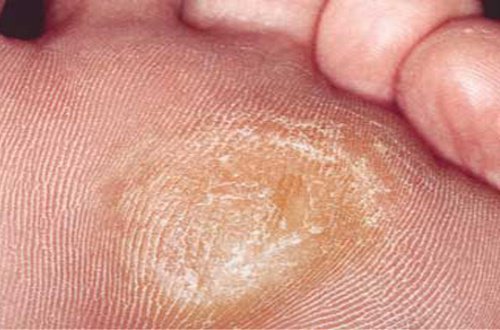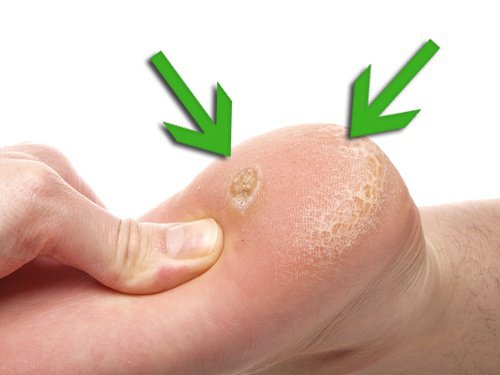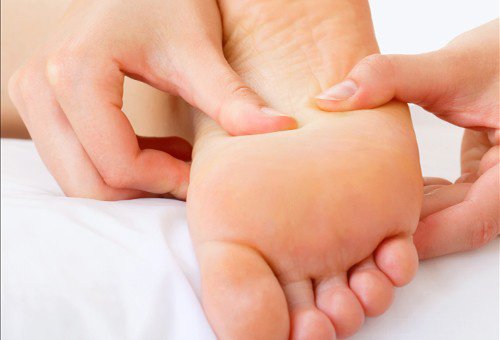7 Remedies for Foot Calluses and Corns

Just like you care for the skin on your face, you should care for your feet too. If you don’t, clear signs of damage and neglect will start to appear. In today’s article, we’re going to teach you some home remedies for foot calluses and corns. Not only will your feet look more beautiful, it will also help reduce some of those aches and pains.
What causes foot calluses and corns?
After a long day, your feet can get really tired. High heels, no socks, dry environments, lack of exfoliation, shoes that are too tight and have been worn too many hours at a time, sweat, etc…These are all things that can cause foot problems.
Foot calluses and corns can form on various parts of your feet, especially on the heel, the sides of the big or pinky toes, and on top of your toes. At first, they’re just annoying, but if you don’t do anything about them they can start to become painful.
If you’ve ever had corns then you already know they can be unbearable. They can keep you from wearing shoes and cause you pain all day long. It’s hard for that not to impact your mood, your work productivity, and even your personality.
Preventing foot calluses and corns
If you’ve never had calluses or corns (what luck!) you should start taking some preventative measures to keep it that way.
For example, moisturize your feet every time you take a bath or shower. You can massage a few drops of olive oil or some petroleum jelly into your feet for deep moisture.
Also make sure you’re wearing comfortable shoes that aren’t too tight, or too loose. If they’re new, put a bandage over places where you know you tend to get blisters or calluses, and don’t wear them for too long at first.
You might like:

If you already have calluses, you should make the infamous pumice stone your new best friend. Just remember to use it carefully and don’t scrub so long that it becomes painful. Always try to use it at after a shower or bath, when the skin on your feet is softer.
You can also use a file to remove any rough edges from your heels, the soles of your feet, or toes. Just don’t do it for more than three minutes a time, and always apply a moisturizer afterwards. Wear comfortable shoes and watch for any signs of pain or discomfort. There are also some home remedies for foot calluses and corns that might help.
Home remedies for foot calluses and corns
Aside from using a pumice stone, calluses and corns can be very painful on their own when you step on them. So, make a note of these home remedies for foot calluses and corns.
Recipe #1 for calluses and corns
Ingredients
- ½ onion
Preparation
Cut an onion in half and rub the raw vegetable on the affected area of the foot. Repeat this procedure every night before going to bed. There’s no need to rinse your feet, just let the onion juice soak into your skin. Put on a pair of socks and go to bed. Onions are a great remedy for foot calluses and corns because they’re curative and anti-inflammatory.
 Recipe #2 for calluses and corns
Recipe #2 for calluses and corns
Ingredients
- 1 clove of garlic
- 1 tablespoon olive oil (15 ml)
Preparation
It’s no surprise that garlic would show up on our list of remedies for foot calluses and corns. It has a ridiculous amount of health benefits.
Mash the garlic and olive oil together and cover the surface of the callus or corn with the mixture. Apply a bandage or cloth over top of the paste and leave it on overnight. Wipe it off in the morning, without rinsing. Repeat this every day until the problem goes away.
Recipe #3 for calluses and corns
Ingredients
- 1 handful of nettle stems and flowers
- 1 tablespoon water (15 ml)
Preparation
Keeping nettle at home is a great idea. Take a handful of stems and flowers and blend them with some water. You’ll get a kind of paste that you can apply directly to the callus or corn. Cover with gauze or a cloth for at least three hours before removing.
Recipe #4 for calluses and corns
Ingredients
- 1 handful of marigold flowers and leaves
- 1 tablespoon water (15 ml)
Preparation
The procedure is the same as with nettle. Apply every night before bed.
Recipe #5 for calluses and corns
Ingredients
- 1 fig
Preparation
This fruit has anti-inflammatory properties and provides freshness and relief. Cut a fig in half, remove the pulp, and apply it directly to the callus or corn before bedtime. Cover with a bandage and wear socks to keep from dirtying your sheets.
Leave on overnight and soak your feet in warm water in the morning. Afterwards, use a pumice stone and lastly, apply your regular moisturizer.
Recipe #6 for calluses and corns
Ingredients
- 2 tablespoons of baking soda (18 g)
- 1 tablespoon of warm water (15 ml)
Preparation
Make a thick paste with the baking soda and water. Apply it to your callus or corn in a circular motion to promote exfoliation. Leave on for 20 to 30 minutes and remove with warm water. Then use a pumice stone or file. Don’t forget to moisturize your feet.
You might like:
Recipe #7 for calluses and corns
 Ingredients
Ingredients
- 4 tablespoons of chamomile (60 ml)
- 1 liter of boiling water
Preparation
Make a chamomile tea. Let it cool for a few minutes and then soak your feet in a bowl with the liquid, but be careful not to burn them. This will soften your calluses and make them easier to remove using a pumice stone. At the risk of sounding like a broken record…make sure you always finish any of these remedies for foot calluses and corns with a moisturizer.
All cited sources were thoroughly reviewed by our team to ensure their quality, reliability, currency, and validity. The bibliography of this article was considered reliable and of academic or scientific accuracy.
- Abad, C., Piñero, S., Proverbio, T. Proverbio, F., & Marín, R. (2005). Sulfato de magnesio. ¿Una panacea?. Interciencia, 30(9), 36-50.
-
N. Bhagyalakshmi, R. Thimmaraju, L. Venkatachalam, K. N. Chidambara Murthy & R. V. Sreedhar (2005) Nutraceutical Applications of Garlic and the Intervention of Biotechnology, Critical Reviews in Food Science and Nutrition, 45:7-8, 607-621, DOI: 10.1080/10408390500455508
-
Benvenuti, F., Ferrucci, L., Guralnik, J. M., Gangemi, S., & Baroni, A. (1995). Foot Pain and Disability in Older Persons: An Epidemiologic Survey. Journal of the American Geriatrics Society. https://doi.org/10.1111/j.1532-5415.1995.tb06092.x
- Grouios, G. (2004). Corns and calluses in athletes’ feet: A cause for concern. Foot. https://doi.org/10.1016/j.foot.2004.07.005
- Menz, H. B., & Morris, M. E. (2005). Footwear characteristics and foot problems in older people. Gerontology. https://doi.org/10.1159/000086373
- Mero Espinosa, M., & Licea Puig, M. (2020). Deformidades podálicas adquiridas en personas con diabetes mellitus tipo 2, un factor de riesgo de pie diabétio. Revista de la Asociación Latinoamericana de Diabetes, 10, 54-65.
- Hashmi, F., Nester, C., Wright, C. et al. (2015) Characterising the biophysical properties of normal and hyperkeratotic foot skin. J Foot Ankle Res, 8, 35. https://doi.org/10.1186/s13047-015-0092-7
- Grouios, G. (2004). Corns and calluses in athletes’ feet: a cause for concern. The Foot, 14(4), 175-184.
- Bannerman, E., Stevenson, J., (2017) Dermatology Issues in Sports Current Sports Medicine Reports, 16(4), 219-220.
- Sagar, A., Dhandar, K. & Bakal, R. (2022). Medicinal herbs: Why to include in diabetic foot ulcer therapy? A review Innovations in Pharmaceuticals and Pharmacotherapy, 10(2), 8-13.
This text is provided for informational purposes only and does not replace consultation with a professional. If in doubt, consult your specialist.








